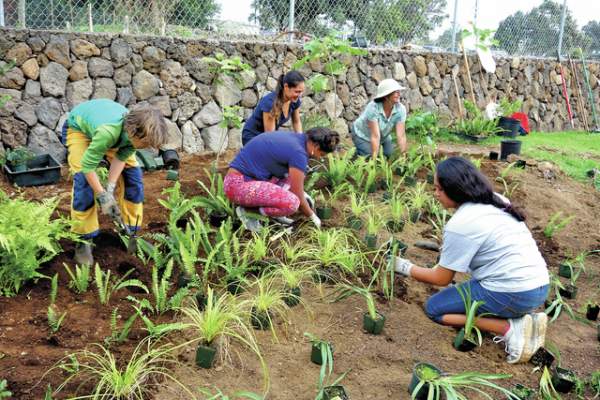
On Wed. Feb. 1, extension agent, Lisa Ferentinos from the University of Hawaii Sea Grant College Program (UHSGCP), student volunteers from the Kohala Center’s after school program, Ke Kumu Aina and Julia Rose from The Nature Conservancy and the South Kohala Coastal Partnership installed a rain garden in the northeast corner of the Waimea Shopping Center’s back lot.
The garden is a shell shaped slope and is made up of a selection of native Hawaiian plants such as ilima, mamaki, uhi uhi, mau hau hele, ti and ohia to name a fewki. “The idea is the plants in the lowest part of the garden are adapted to being wetter. The ones in the upper part are adapted to being draught tolerant and the ones in the middle can handle a little bit of wet and a little bit of dry,” said Ferentinos.
The run-off will be directed to the garden through a sub-surface pipe. “The idea is the water comes in off the parking lot into this low area. There's a pipe that will help distribute the water. You use the plants to bio-mediate any of the pollutants. The plants will take up the water and anything that's in the water and any water that goes into the stream will be filtered,” explained Ferentinos.
The rain garden project for Hawaii Island began back in 2014 through a conservation partnership. “The South Kohala Coastal Partnership (SKCP), of which UHSGCP is a member, helped find funding to do an assessment of Waiulaula Stream for the worse erosion hot spots. That was completed in 2014,” said Ferentinos.
Once five hot spots were identified, “They (SKCP) got funding from the Department of Health Polluted Run- off Control Program to address some of the worse erosion hot spots along Wai’ula’ula Stream,” said Ferentinos.
Although there are many rain gardens that have been developed on Oahu, Ferentinos has adapted the design of the Waimea garden to fit the conditions. “This one might be the first on the Big Island. There's quite a few on Oahu, but they're at sea level and it's a different situation, different soil, different plants,” said Ferentinos.
The rain garden is one of many strategies to address run-off along the Wai’ula’ula Stream corridor. The first effort was to plant a strip of kikuyu, for its low maintenance, and native hibiscus along the bank of the stream, directly behind, the center’s courtyard.
The next hot spot will be at the Ulu La’au Nature Park, where, Kohala Center’s Ke Kumu Aina program is centered. The group meets on Wednesdays from 1:30 to 5:00 to explore and learn about Hawaii Island’s native plants.
Ke Kumu Aina Program Coordinator, Mahina Patterson and her students, who helped plant the rain garden, will be on hand to help. “We will install erosion control matting and coconut fiber logs and vegetation to slow down the erosion of the banks. We already have a trial area to make sure that the concept we were considering was workable and we're in the process of ordering the materials and getting the labor contracted to do that site, which we expect to happen in another couple of months,” said Ferentinos.
The skilled, enthusiastic hands of Ku’ulei Kumai-Ho from Waimea Middle School; Shaelynne Monell-Lagaret from Kanu o ka Aina and Julian Fried from HPA soon have the garden planted and blessed with positive intensions. But the care for the garden doesn’t stop there.
“In Hawaii there's no such thing as no maintenance. That's a huge challenge with all environmental projects here. We're trying to get school groups to adopt areas that we're doing our projects in. We're trying to get teachers at Parker School and Waimea Middle School engaged. The idea is that each school or class can take on some part that matches up with their educational goals,” said Ferentinos.
The rain garden is both a little bit experiment and a way to educate the community about how they can help prevent run-off. “Once the plants are established we're going to have a workshop and invite the community to come and learn about rain gardens. We're trying some techniques and plants that haven't been tried before, so once we get an idea of how well it's working then we'd like to invite the public to come and learn about it,” said Ferentinos.
The effort to prevent run-off is a whole community affair and requires individual awareness of causes and how they can be fixed. “We’re hoping to encourage folks to install rain gardens at their homes to deal with any run off from their impervious surfaces like driveways or roof tops and encourage other folks in the community to consider using rain gardens to have the excess infiltrate rather than run off into the stream,” concluded Ferentions.
On Oahu, the Hui o Koolaupoko has been working on several projects to prevent run-off and has created a rain garden manual that can be accessed at: http://www.huihawaii.org/uploads/1/6/6/3/16632890/raingardenmanual-web-res-smaller.pdf
The assessment of Waiulaula Stream can be accessed at:
http://www.southkohalacoastalpartnership.com/uploads/2/5/7/1/25718612/southkohalasca_final_sept2014.pdf
 RSS Feed
RSS Feed
